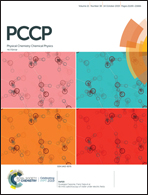Ground and excited state properties of furanoflavylium derivatives†
Abstract
The comparison of the ground-state reactivity of anthocyanins and aurone model compounds (i.e. with and without the furano bridge) has shown that the kinetic paradigm does not depend on the bridge but only on the hydroxyl substituent pattern, independently of the presence of the bridge: (i) bell shaped kinetics for those with two hydroxyl substituents in position 4′ and 7, and (ii) four distinct kinetic steps for the mono substituted compounds with a hydroxyl in position 4′. The excited state proton transfer (ESPT) properties of these compounds were also investigated using steady-state and time-resolved spectroscopic techniques. It was found that the ESPT efficiency is significantly higher for the bridged compounds. Interestingly, pH-dependent steady-state fluorescence emission experiments show that in 4′,7-dihydroxyfuranoflavylium the hydroxyl group in position 7 is the more acidic one in the excited state, while 1H NMR titration curves indicate a higher acidity constant in the ground state for the proton at the hydroxyl group in position 4′. Differently, the fluorescence emission spectrum of the quinoidal base deprotonated at position 7 is only observed upon excitation of the flavylium cation while the one from the base deprotonated at 4′ is observed upon direct excitation.



 Please wait while we load your content...
Please wait while we load your content...